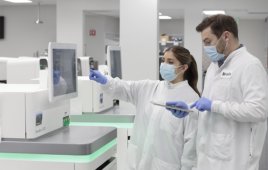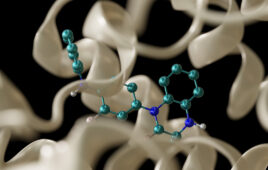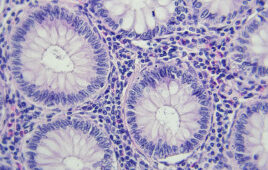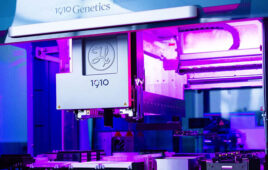Collaborations bridge the gap between drug development and PCR-based companion diagnostic assays in the spirit of a more personalized approach.
|
Was Kerry Mullis insanely brilliant or brilliantly insane? That is the question. And polymerase chain reaction (PCR, for short) is the answer.
This little nucleic amplification method has turned the world upside-down and right-side-up again with sheer beauty, in the way that only a monumental scientific discovery like PCR can. It’s no wonder that Kerry Mullis received the Nobel Prize for his discovery.
PCR has been, and continues to be, the single most important tool in molecular biology. Enabling almost all molecular biology methods, PCR has been applied to basic biological research, drug discovery and development research, environmental research, forensics, and more.
“PCR is widely used to understand biology at the genomic level.” says Walter Koch, PhD, vice president and head of global research, Roche Molecular Diagnostics, Pleasanton, Calif. “As such, it is used as part of the target discovery effort including applications such as gene sequencing, for differential gene expression analysis, or as a preliminary step in areas such as microarray analysis.”
But PCR has gone beyond applications in basic and drug research and into the clinic, as the linchpin for building companion diagnostics. This article will discuss some of the ongoing research which has that aim in mind.
PCR-based diagnostics
For clinical applications, HIV viral load testing—which first became available in the 1990s—is a prime example of the enduring value of a PCR-based molecular diagnostic assay. Commercialized first by Roche Molecular Diagnostics, the test was developed to augment the then-established biomarker for HIV infection, CD4-postive T-lymphocyte count, as a primary endpoint for HIV drug development and to monitor the effectiveness of HIV therapy in the clinical setting. “What has changed since the introduction of the first tests is that we also know that there are viral sequence mutations in HIV that are associated with drug-resistance,” says Koch. “By assessing the presence of these mutations in the protease gene and the reverse transcriptase gene, one can assess the likelihood of how well a patient will respond to a given drug combination treatment.”
|
|
|
More recently, Roche Molecular Diagnostics has ventured into the realm of oncology. One project involves collaboration between Roche Molecular Diagnostics, Plexxikon (Berkeley, Calif.), and Roche Pharmaceuticals. Together, the teams are investigating the utility of the drug target, mutated b-Raf kinase, to select patients for clinical trials involving novel anti-Raf kinase compounds.
“In 70% of melanomas, perhaps 10% of colorectal cancers, as well as others, the b-Raf kinase is mutated, and this has become the target of a specific therapeutic designed to selectively inactivate the mutated kinase,” says Koch.
While Roche Pharmaceuticals is developing the anti-Raf drug, Roche Molecular Diagnostics is developing a real-time PCR-based companion diagnostic assay to test for the V600D mutation in the b-Raf gene. The test is designed for use in clinical trials, and if these are successful, to help physicians better identify patients who are candidates for this specific therapy. Initiating test development while the drug is still in clinical trials is intended to support the goal of launching both the drug and companion diagnostic simultaneously.
|
PCR at the start
A nother collaborative effort between Roche Pharmaceuticals and Roche Molecular Diagnostics is to work on developing a companion molecular diagnostic assay for MDM2 inhibitors, a novel class of anticancer agents developed by Roche called Nutlins. MDM2 is a protein that targets the p53 transcription factor for degradation, thus reducing its pro-apoptotic activity in normal human cells. Cancer chemotherapeutic agents that cause DNA damage activate the p53 pathway in cancer cells, thus resulting in their demise by apoptosis.
“If you could increase levels of p53 by blocking its interactions with MDM2, then that same program would be turned on and you would cause the cancer cells to commit suicide in the absence of any damage,” says Koch. By binding to the p53-binding cleft of MDM2, Nutlins do exactly that. Of course, biology never allows things to be THAT simple.
“In approximately 50% of all cancers, p53 is mutated. And when it is mutated, this approach is not going to work,” says Koch. To deal with this additional kink, Roche Molecular Diagnostics has designed an assay that first PCR-amplifies the p53 gene from DNA samples taken from each prospective clinical trial candidate, then uses a sequencing microarray to determine the p53 genotype. The idea is to identify patients who would or would not, based on p53 mutation status, be likely to respond to treatment with Nutlins. Currently, both the Nutlin and its companion diagnostic assay are still in development.
Let’s get clinical
|
David Persing, MD, PhD, executive vice president and chief medical and technology officer at Cepheid, Sunnyvale, Calif., knows a thing or two about designing molecular diagnostic assays. Rooted in second-generation PCR technology since its inception, Cepheid’s molecular diagnostic assays incorporate everything one needs to run the assays from sample prep to detection in a single, disposable cartridge. Each cartridge contains a single assay type and runs in a module in the instrumentation, which can run up to 48 independent modules, simultaneously, thereby eliminating the wait time associated with batch-mode processing.
“If you need a test result quickly and available on demand and around the clock in order to effect a treatment decision for a particular antibiotic, for instance, then batched testing is really not an option,” says Persing. “So the kind of testing that we developed is really ideally suited for the pharmacodiagnostic applications that are being discussed in a lot of different contexts right now.” Cephid is now in discussions with multiple pharmaceutical companies interested in using one of their premiere technologies, the GeneXpert, to rapidly select clinical trial candidates for novel therapies against methicillin-resistant Staphylococcus aureus (MRSA).
All of Cepheid’s molecular diagnostic tests work by real-time PCR using fluorescent probes, which utilize many different fluorescent technologies including molecular beacons, scorpions, and TaqMan from Applied Biosystems. Cepheid’s instrumentation contains six different color channels that allow for simultaneous detection six independent reactions. After reserving one channel for an internal control, the other five channels can be used to detect amplification of five other targets from MRSA, for instance. “In the case of our MRSA SA assay, we detect two drug resistance markers and a species-identifying marker,” says Persing.
“Compared to other types of molecular methods, PCR is by far the most versatile,” says Persing. “PCR detects both DNA and RNA targets readily … can be multiplexed … is the technique that is going to be the mainstay of molecular diagnostics in the future.”
This article was published in Drug Discovery & Development magazine: Vol. 11, No. 11, November, 2008, pp. 30-34.
Filed Under: Genomics/Proteomics








